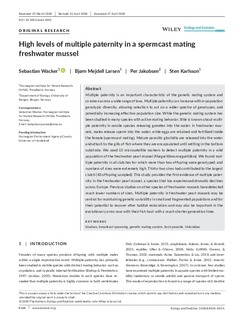High levels of multiple paternity in a spermcast mating
Journal article

Åpne
Permanent lenke
http://hdl.handle.net/11250/2574572Utgivelsesdato
2018Metadata
Vis full innførselSamlinger
- Scientific publications [1392]
Originalversjon
10.1002/ece3.4201Sammendrag
Multiple paternity is an important characteristic of the genetic mating system and
common across a wide range of taxa. Multiple paternity can increase within-population
genotypic diversity, allowing selection to act on a wider spectre of genotypes, and
potentially increasing effective population size. While the genetic mating system has
been studied in many species with active mating behavior, little is known about multiple
paternity in sessile species releasing gametes into the water. In freshwater mussels,
males release sperm into the water, while eggs are retained and fertilized inside
the female (spermcast mating). Mature parasitic glochidia are released into the water
and attach to the gills of fish where they are encapsulated until settling in the bottom
substrate. We used 15 microsatellite markers to detect multiple paternity in a wild
population of the freshwater pearl mussel (Margaritifera margaritifera). We found multiple
paternity in all clutches for which more than two offspring were genotyped, and
numbers of sires were extremely high. Thirty-two
sires had contributed to the largest
clutch (43 offspring sampled). This study provides the first evidence of multiple paternity
in the freshwater pearl mussel, a species that has experienced dramatic declines
across Europe. Previous studies on other species of freshwater mussels have detected
much lower numbers of sires. Multiple paternity in freshwater pearl mussels may be
central for maintaining genetic variability in small and fragmented populations and for
their potential to recover after habitat restoration and may also be important in the
evolutionary arms race with their fish host with a much shorter generation time.
